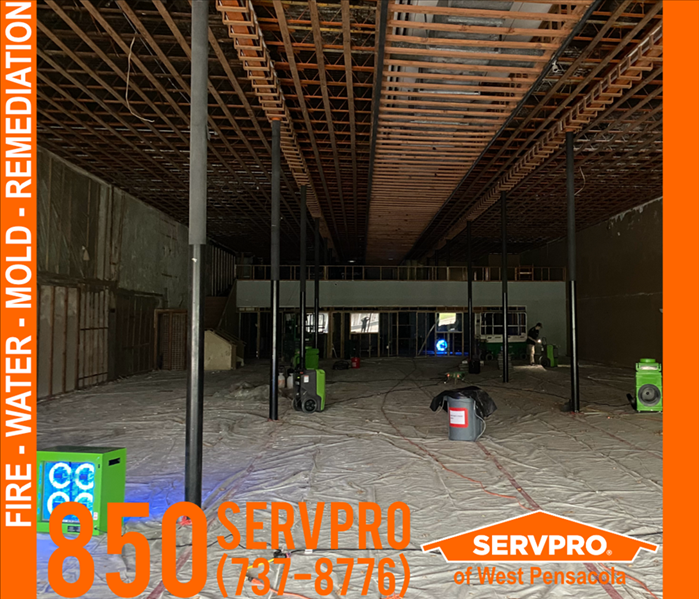Weathering the Storm: Essential Steps for Water Damage Restoration in Pensacola
3/14/2024 (Permalink)
Living in Pensacola, Florida, means being prepared for the occasional onslaught of severe weather, particularly hurricanes and tropical storms. While the picturesque coastal city offers many delights, it also faces the constant threat of water damage. Whether from heavy rains, storm surges, or flooding, water damage can wreak havoc on homes and businesses alike. In this blog post, we'll discuss essential steps for water damage restoration in Pensacola, helping residents and property owners navigate the aftermath of these natural disasters.
Safety First: Before embarking on any restoration efforts, prioritize safety. Ensure that the affected area is free from electrical hazards, structural damage, and contaminated water. If the damage is extensive or poses significant risks, seek professional assistance immediately. Your safety and well-being should always come first.
Document the Damage: Take photographs or videos of the water damage to provide evidence for insurance claims. Document the extent of the damage to both the structure and your belongings. This documentation will be crucial when filing insurance claims and can help expedite the restoration process.
Assess the Water Source: Identify the source of the water damage. Is it from a burst pipe, roof leak, or flooding? Understanding the source will help determine the appropriate course of action for restoration. If the water source is from contaminated sources such as sewage or floodwaters, exercise caution and consider hiring professionals for cleanup.
Extract Standing Water: Remove standing water from the affected area as soon as possible to prevent further damage and mold growth. Use pumps, wet vacuums, or buckets to extract water from floors, carpets, and other surfaces. Thoroughly dry the area using fans, dehumidifiers, and ventilation to minimize moisture levels.
Salvage and Remove Damaged Items: Inspect furniture, appliances, and personal belongings for water damage. Salvage items that can be restored through drying and cleaning processes. Dispose of severely damaged items responsibly. Prompt removal of damaged materials can prevent mold growth and mitigate health risks.
Clean and Disinfect: Thoroughly clean and disinfect all surfaces affected by water damage to prevent mold and bacteria growth. Use appropriate disinfectants and antimicrobial solutions to sanitize the area effectively. Pay special attention to hidden spaces such as wall cavities and under flooring.
Address Structural Damage: Assess the structural integrity of the building and address any damage promptly. Repair damaged roofs, walls, and foundations to prevent further water infiltration and structural deterioration. Seek professional assistance for extensive structural repairs.
Dry and Dehumidify: Ensure thorough drying of the affected area to prevent mold growth and secondary damage. Use dehumidifiers, air movers, and moisture meters to monitor and control moisture levels. Proper drying is essential for restoring the property to its pre-damage condition.
Monitor for Mold: Monitor the affected area for signs of mold growth in the days and weeks following water damage. Mold can proliferate rapidly in damp environments, posing health risks and further property damage. If mold is detected, address it promptly with appropriate remediation measures.
Restore and Renovate: Once the affected area is thoroughly dried and sanitized, begin the restoration and renovation process. Replace damaged materials, repair structural components, and restore the property to its pre-damage condition. Work with reputable contractors and restoration professionals to ensure quality results.
Review Insurance Coverage: Review your insurance policy to understand your coverage for water damage restoration. Document the damage thoroughly and file a claim promptly to expedite the reimbursement process. Communicate with your insurance provider and seek clarification on coverage details if needed.
Prepare for Future Events: Learn from the experience of water damage and take proactive measures to mitigate future risks. Invest in preventative measures such as storm shutters, sump pumps, and waterproofing solutions. Develop a comprehensive emergency preparedness plan to safeguard your property and belongings.
Conclusion: Water damage restoration in Pensacola requires swift and systematic action to minimize damage and restore affected properties. By following these essential steps, residents and property owners can navigate the challenges of water damage with greater confidence and resilience. Remember to prioritize safety, document the damage, and seek professional assistance when needed. Together, we can weather the storm and emerge stronger on the other side.





 24/7 Emergency Service
24/7 Emergency Service
